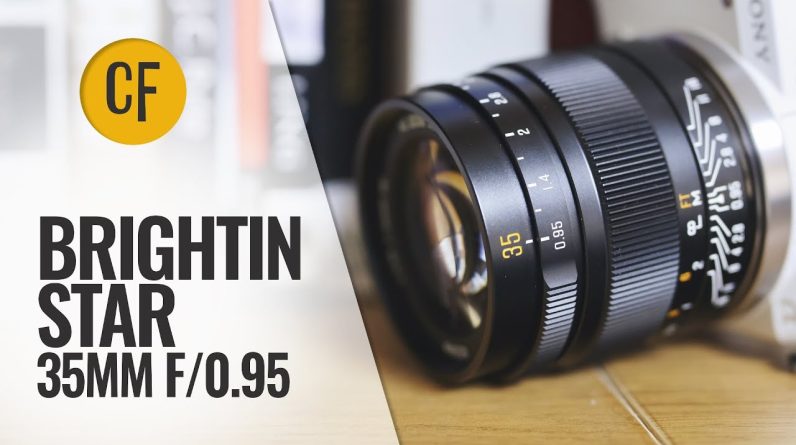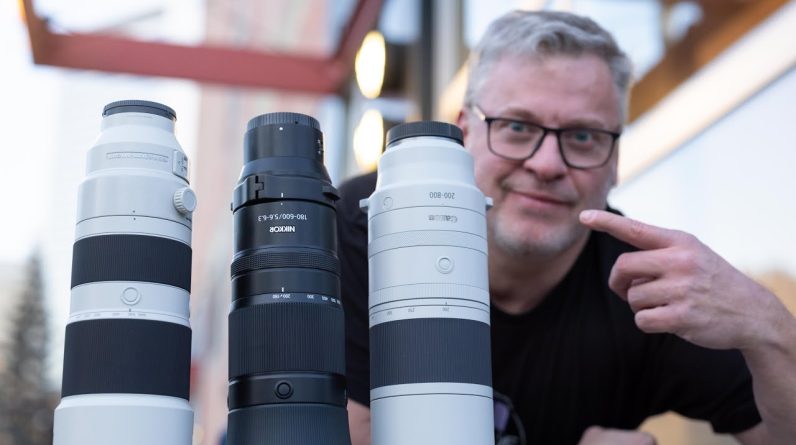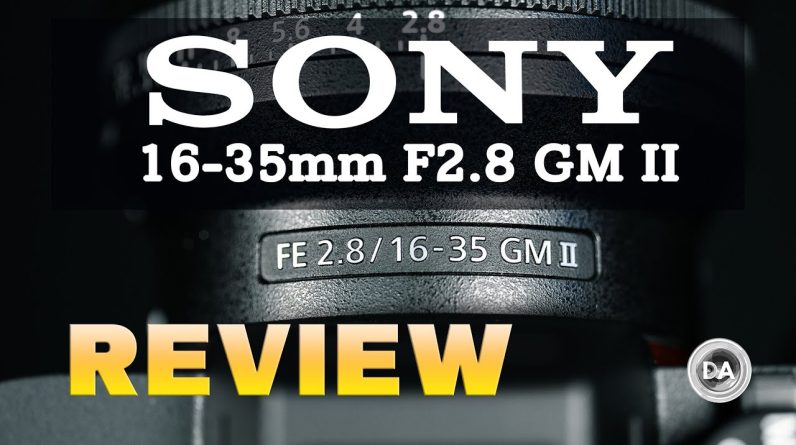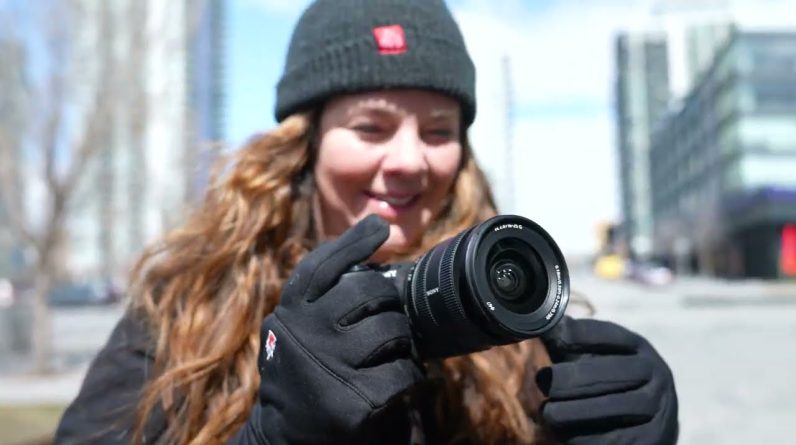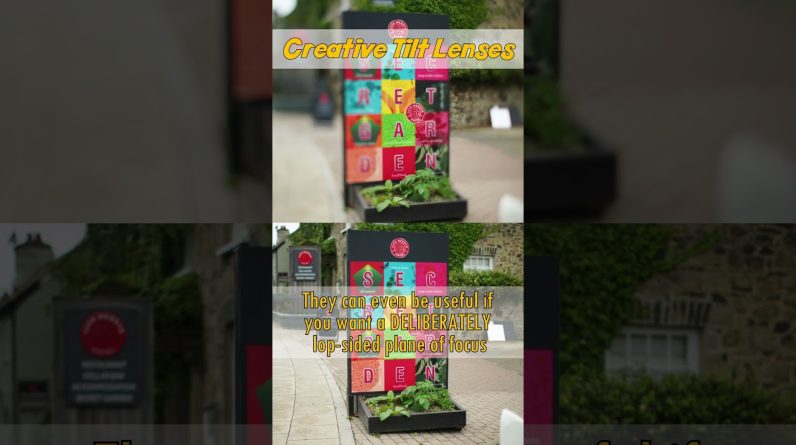What if there was a camera
that was nearly identical To the a7S III,
but with 33 megapixels, The Sony a1’s
autofocusing system, Ergonomic improvements And all for $1000USD less Than the aforementioned a7S III? Well, that’s not exactly
what this camera is, But it’s darn close. Let’s get undone. [offbeat music] ♪ Gerald Undone ♪ ♪ He’s crazy ♪ What’s happening everybody?
I’m Gerald Undone. And in an alternate universe,
I review wooden furniture. Alright, disclosure. Sony lent me this camera
to make this review. This is a pre-production model.
I don’t get to keep it. No money changed hands,
and Sony does not get any input On this video’s production Or get to preview
before it’s posted. This video does have
a sponsor, though, And that’s Storyblocks. Normally when you do
camera reviews, You talk about all
the strengths of a product And then balance that
with the drawbacks. This time, I’m going to flip it
and start with my complaints About this otherwise
nearly perfect camera. 4K60 has a crop. Recently, I made a video
with Josh Yeo listing All the things
we wanted in the a7 IV. And while Sony did achieve
pretty much all of them, I suggest that perhaps
they should keep the resolution At 24 megapixels
and work instead on achieving An uncropped 4K60
and reduce rolling shutter.
Instead, we have 33 megapixels
and a crop 4K60 mode. Now that APC crop does have Decent rolling
shutter performance, Which you can also enable At other frame rates
if you so choose. However, the regular full
frame modes for 24, 25 And 30p are all doing
a full 7k oversampling, Which, while it creates
a very sharp image, Has terrible rolling
shutter performance. But this is where it
gets interesting. If you’re the current owner
of an a7 III And don’t have a problem With the rolling shutter
on that camera, Then this new camera is nothing
but upgrades for you Because the rolling shutter
is pretty much identical To the a7 III,
except now you have A 33 megapixel
photo camera as well. If, however,
you’re coming from an a7S III Or an a1 and you wanted
a second camera, please know That this camera is a major
step back in rolling shutter. The same goes
for the flip screen and the EVF. If you’re coming from an a7S
III, these displays are worse, But if you’re coming
from a7 III, They’re a bit of an improvement And the panel
is now fully articulating And there’s no 4K120 mode, But I really wasn’t
expecting that, So I’m not docking any points. There’s also the bug
in the pre-production models That I’ve already
reported to Sony, But I’ll document it
here as well for transparency And to ensure it gets fixed. It has to do with this
new selection dial added. On this camera, you have
a separate selector for photo,
Video and s and q modes,
which I think is great Because it removes
those functions From the top of the mode dial, Making the modes independent
and faster to access. However, if you swap batteries While the new selector
is set to video, Most of your buttons don’t work
when you turn it back on. Unless you switch the dial
to photo, then back to video. If you start
in photo, it’s fine. It’s just if you start in video And re-seat the battery
that the problem occurs. This is obviously
a pre-production bug, And I’m confident
it’ll be fixed. Speaking of that battery,
same as usual, it’s an FZ100, Which should get you over
two hours of recording time In regular frame rates in just
under two hours in 4K60. And it also features
USB-C power delivery, Which can charge the camera Or extend your runtime
indefinitely if recording. It didn’t seem to have
an impact on overheating. In fact, overheating
was not really an issue In any reasonable
scenario I tried. If you follow
the standard practice Of opening the screen up, Keeping it clear from surfaces And setting the auto power
off temp to high, I don’t think you’ll experience
overheating on this camera In moderate temperatures
or regular studio use In any of the modes, even 4K60. In fact, I recorded
for three hours in 4K60 With USB power provided Before getting bored
and shutting it down. I will say, though, that
the camera does get quite hot When you do
those long 4K60 tests,
Probably too hot to comfortably
hold in your hand. So that kind of prolonged use is
better served for tripod work. But I suppose most people will
only be shooting handheld 4K60 In shorter bursts anyway, And I was able
to get it to overheat If I close the LCD screen Or if I rested it
on a cushioned surface. So don’t do that. The only other difference
physically I could spot Between this camera
and the a7S III Is they’ve changed
the exposure compensation dial Into a multi-use one that
can be programmed in the menu So you can set it
to EV if you want. But it can also be set to ISO
or white balance now, et cetera, And you can lock it. This is great and has made
a noticeable impact on handling, And they’ve added the closed
shutter option from the a1 When you turn the camera off
to keep dust off your sensor During lens swaps. Big fan of that function. We’re getting the same
new menu system from the a1 And a7S III, including
the additions like S-Cinetone. Even the variable shutter
option from the a1, Which lets you fight
off flicker in video mode By using a slightly adjusted
shutter integer Similar to Synchro Scan
on the Panasonic cameras, But this camera
also has new features That aren’t in those
other two bodies yet. And I say yet because Sony,
you better be adding these To the more expensive cameras,
especially the a1. Those features include animal
eye tracking and video, Which work quite well
in my tests. It might not be as good
as human eye detection, But it’s respectably sticky
and performed well.
Only time I ran into issues Is when there were
two cats in the frame. It didn’t seem to know who
to track in those situations, But the regular autofocus
picked up the slack there, And the shot was still fine, and
the autofocus speed was good. So overall, I’m happy. This was using the new
70-200 II, by the way. The autofocus
and video on this camera Is Sony’s best
right up there with the a1, Which will be a huge upgrade
for a7 III users. And you can also leverage
the touch tracking as well, Which will be new
to a7 III users But familiar
to S III and a1 owners. Another new menu option Is a lens correction
for focus breathing. It only works
with certain lenses, Mainly those G master primes
that I gave such a hard time For their terrible focus
breathing like the 35mm F1.4 Or the 50mm F1.2. It works by knowing
the extent of the breathing And then applying a crop
to hide any of that breathing While shooting, basically
you end up with a tighter shot That doesn’t breathe. It’s extremely useful and again,
is something I want to see Added to those
other two cameras as well, Along with the Animal Eye AF. There’s also this new
thing called Focus Map, Which gives you a colour coded
display of what’s in front Of focus on the focal plane
and what’s behind. But I find it busy
and hard to look at And don’t really care to use it. When it comes to image quality,
I already mentioned that you’re Getting a seven K oversample
in the full frame modes. But due to the increased
resolution of the sensor,
You’re also getting a slight
oversample in 4K60 as well Around 4.6 K, I believe. Giving this camera
the sharpest image And video available for Sony Save for the 8K mode on the a1. This oversampling also reduces
the impact of noise In your low light scenes,
which contributed to this camera Scoring a 12.8
in my dynamic range test With Imatest AMaZE 21. This is using the new,
more challenging scoring method That CineD helped me with,
and in that it actually scored About a third of a stop
better than the a7S III, Putting it right
in line with the a1, Which again is a huge upgrade
for an a7 III owner. I was actually quite impressed With the noise performance
on this camera. If we move through
the ISO range in S-Log3, Which starts
at the base of ISO 800, We can see the second native
ISO kick in at 3,200 And then remain impressively
clean up past 12,800. I’d feel comfortable
using this camera As high as 25,600
in many situations. However, at 32,000,
it completely falls apart, But still overall
very impressive, And the colour matches nicely
with the a7S III and a1 as well As usual when you’re dealing
with a new sensor, Tere’s slight differences
in the white balance. The a7S III, leans a bit green,
the a1 a bit magenta, And this new camera is
somewhere in the middle. But these are very minor shifts, And if you custom white balance
each camera separately, They turn out to be extremely
close colour wise, And mixing the footage
shouldn’t be a problem. And because it offers all
the new Kodak options as well,
Including 10-bit 4:2:2 You can comfortably shoot
in S-Log3 And not worry about the image
falling apart Like it did on the a7 III. Speaking of those codecs, This camera has H.264 and H.265, And it even has
All Intra recording, Which is something
I wasn’t expecting And was pleasantly
surprised with. The card slots are slightly
different though, There’s only one
of the a7S III’s dual bays That feature both a
CFexpress type A and SD slot. The second bay is just
an SD card slot, But both of them are UHS-II. The 4K30 mode
is much improved as well, If you’re coming
from an a7 III, first off, There’s no crop and your
autofocus isn’t affected, And they’ve even
increased the bit rate When you increase frame rate, Which makes sense
and is much better Than the previous
generation of cameras. And although 4K60 has a crop, You can still enable active
stabilization in that mode, Which is nice
as this camera features The same great stabilization
modes of the a7S III. And if you’re coming
from an a7 III. Rest assured there’s none
of that silly HDMI stuff Where your face
detection stops working Or one of your screens
goes black if you dual record, But it still does have
the issue that I think All Sony cameras have where
you lose the camera screen, If you output
your onscreen display info Onto an external monitor,
I wish they would fix this. A couple of smaller
improvements I’ve noticed
That actually make
a pretty big difference. This is the first
Sony camera I’ve used That you can effortlessly
bring up your battery life If you’re running
a minimalist display. On every other camera,
the battery icon disappears After a few seconds, and there’s
only a couple of ways That you can bring it back up, Either by cycling
through your display modes Until you get the one
with all the stuff on it Or what I do enter
and exit the menu quickly. This camera, you can bring it up
by half, pressing the shutter Or pressing AF-ON or a bunch
of other much easier ways, And I really appreciate this. And they’ve also added an AF
assist function in video mode That feels a lot like
a DMF mode in photo. Basically letting you manual
focus override at any point During continuous
autofocus or video. This is a handy tool, But it does bring
with it one interface change Compared to the a7S III or a1. On those cameras, if you turn on
focus peaking, you only see it When the lens is in manual
focus mode. On this camera,
when focus peaking is on, You see it in both modes
manual or auto focus. I assume this is to help With that new AF
assist override function, But it took some
getting used to. And if you’re looking to use
this camera as a webcam as well, The whole experience
has been upgraded. So first off, when you plug
in USB cable to this Now, it will bring up a prompt So you can choose what kind of
USB mode you want to use And whether it’s data
transfer or not. And one of those options will
be to use it as a webcam.
And as soon as you choose that It is a hassle free universal
webcam device recognized By your computer, and then the
resolution and frame rate modes Have been improved as well.
I think on the previous Sony webcam versions,
it was a 720p cap. Now you can shoot 1080p
all the way up to 60 fps, And 4K at 15 fps If you plan to use that,
but that 1080p 60, And the ease of use makes
this actually A really viable webcam now. So as you can see for video, This camera is literally nothing But upgrades compared
to the a7 III, And it matches or beats the a7S
III, In colour, dynamic range, detail And autofocus performance and
due the lower second native ISO It offers a much cleaner middle
ISO range of 3,200 to 6,400 Compared to the a7S III, And it offers added
versatility with An APS-C crop mode. The only areas where The a7S III takes
back big wins is in The high frame rate modes,
which are uncropped And go all the way to 120p
on that camera. And of course,
in the rolling shutter, Which is terrific
on the a7S III, And kind of lousy
on the a7 IV, which, Of course had me a bit
worried about The vlogging capabilities
of this camera. So earlier this week,
I took it out For a vlog test,
and here’s how that looked. I’ve got the camera set
up with an ND on Because we’re going
to go outside. I’ve got the ISO
set to auto ISO
And I’ve put exposure
compensation to plus 1.7 stops Because we’re shooting
in S-Log3. And I think that usually gives
you the best balance between, You know, noise reduction and
also have auto white balance on. This is the 20 millimeter–
Sony 20mm f 1.8. And I’ve got the camera’s Focus breathing
compensation turned on, So it’s a little bit tighter So that the 20mm
doesn’t focus breathe And it’s doing a really
good job of that. Stabilization right now is
just set to standard. I’ll switch it to active
a little bit later on. So I’m going to walk
through the studio And see how it adjusts to
the changing exposure And white balances. Over here I’m being lit by just some,
you know, Household tungsten coloured
fixtures And the ISO jumped up to 10,000. And then I’m going to jump
through here and go through The studio, which is
daylight balanced, And we’re getting about
a 2,500 ISO Because again, I have a two stop
ND on while on the variable. And then
if I walk over here, I’m going to be lit by a window Which should have kind
of a cooler light today, And it’s ISO 3,200 And this is window light
from outside. Now let’s go outside and
see how it works. Okay, so we’re outside now, And I’ve got the five stops
on the ND now, And the ISO is ranging between
800 and 1,250, depending on, You know, whether I’m covered
by a tree or not. And I’m using the Eye detect
auto focus and again, Standard stabilization.
So far, so good.
Again, this camera
does have sort of A rolling shutter problem, So we’ll see if the
stabilization is enough To compensate for that,
you know, Somewhat not great
rolling shutter. If I kind of, you know, move
it around a little bit, Obviously don’t do that, But it’s probably
pretty Jell-O-y. Okay, let’s switch it over
to active stabilization And just sort of monitor
everything all at once while I tell you about today’s
sponsor Storyblocks. All right, we’ve got the
complete package now. Active stabilization,
autofocus, auto ISO, Auto white balance.
Here we go, sponsor read. Have you ever found yourself
in a position Where you could
really use some footage, But shooting it yourself
was either budgetarily Or logistically unfeasible?
Well, Storyblocks Has you covered with an
impressive collection Of stock footage covering A wide range of subjects with
unlimited downloads And 4K video. They’re also amply
supplied with backgrounds, Overlays,
and after effects templates. And the interface is easy
to use and navigate, And the clips are royalty
free for both personal And commercial use so
you can use them as much As you want, wherever you want. So if you think you could
take advantage of A fantastic library of quality
stock footage and effects, Check out Storyblocks using the
link in the description below. So reviewing that footage, it
was better than I expected. The rolling shutter
issues were there, But the improved stabilization,
I think, Did make a difference compared
to how these types of shots
Used to look on the a7 III. But I’ll leave that final
opinion up to you. What I can say, though, Is that if you never
had a problem With rolling shutter on a7 III
and enjoyed vlogging with it, There’s nothing but upsides
moving to this camera. But if you have the extra money, I still think the a7S III is the
ultimate vlogging camera. And since I spent most
of my time Testing the video features
of this camera. I’d like to throw to someone
who had more of a chance To inspect the photo
capabilities of the a7 IV, So let’s see
what portrait photographer Miguel Quiles has to say. Thanks, Gerald.
There’s a lot to talk about With this new camera
when it comes To the photography side of
this conversation. If you are coming from
the a7 III, There’s a lot to love
with the new a7 IV. First would be
the improved ergonomics. I found the original
a7 III to be A little uncomfortable to hold
for long periods of time, Mainly due to my pinky not
really having anywhere To comfortably rest.
Because of that, I would end up using
a battery grip Any time that I used the a7 III
since it improved The ergonomics considerably.
With the a7 IV It has the same body style
that I love From the Alpha 7R IV
and the Alpha 1, Which gives you a bit of a
chunkier battery grip. This new body style
was the first in The a7 lineup where I didn’t
run out and buy A battery grip right away. Since I was able to
comfortably hold
The camera in either landscape
or portrait orientations, The next thing that really
stands out to me With the a7 IV is the benefits
that come with The inclusion of the new
Bionz XR processor. This new processor that was
introduced with the a7S III, And the Alpha 1 gives you
access to some awesome Benefits that photographers
will enjoy. Things like improved real time
autofocus tracking Could be a game changer
for portrait photographers, Especially those who rely on The eye autofocus feature like
I do. Using wide area Continuous autofocus with some
of Sony’s latest lenses Really show how far mirrorless
technology has come. Shooting portraits on location
and in a studio At a variety of apertures gave
me solid results. When you can leave a camera
to take care of The technical side of
taking a photo, Especially when it comes
to focusing. It’s going to open you
up to focus on The more creative elements
that can make A photo really stand out. I’ve been able to use
Sony’s cameras For over six years now,
photographing people With a wide range
of skin tones. When the a7R IV came out, There was something about
the colours that I don’t know that felt
different than any other Sony Camera that I had used
up to that point. Skin tones in my RAW
files look richer, And they seem to require A little bit less work
in post-production, And I’m seeing the same benefit
here with the a7 IV. Depending on the type of
photography you’re into, This benefit alone might
be worth the upgrade.
These days, I mainly
use the Alpha 1 As my main stills camera, So I’m a bit spoiled when it
comes to my expectations Of what a stills camera can do. With that said, though, I think that photographers get
many of the benefits In the a7 IV, that the more
expensive a1 offers. Things like
the improved buffer speeds, Faster and more accurate
autofocus. The inclusion of the faster
CFexpress Type A card slot, The improved JPEG engine
and colour science overall, You’re really
going to see The performance increases
when you pair up The a7 IV with some
of the newer lenses, Like the Sony 70-200
GM version two And they’re 50mm F1.2 GM. All of the benefits that I
mentioned earlier with The increased 33 megapixel
resolution And smaller file sizes compared
to the R IV And the Alpha 1 make
this a great value For anyone that’s looking
to get into full frame Photography without compromise. The original a7 III really
set the standard for what A basic full frame
camera can offer, And here they definitely
step things into A whole new territory. If you want to hear more about
using the a7 IV for stills And specifically portrait
photography, Come check out the full video
on my YouTube channel. Big thanks to Miguel for
providing that segment. Make sure you check out his
video when you’re done here. So I have played around
a little bit with The photo mode on this camera, And I did notice a couple of
differences when compared
To the a1 that’ll be familiar
to a7 III users. The shutter is loud again
when on mechanical mode. [loud clicking] I forgot how loud these
shutters were. I’ve become accustomed to the
new flagships, I guess, But I also like how they’ve
gone back to separating The mechanical shutter from the
electronic front curtain And from the silent shutter
mode on this camera. On the a1, those first
two are combined. I prefer having them as
separate options, And I like how they
did that here. Of course, expectedly,
the drive speed Isn’t as fast
in this camera as the a1. This camera tops out at
10 frames per second, Regardless of the shutter mode. I’ve also enjoyed having
the flip screen For low shots in portrait
orientation, Which is something that I can’t
do too well on my a1 And that I’ve kind of missed. Summarizing this camera is
difficult. I’ve been spoiled. I have an a7S III and two a1s.
That’s not a flex. That’s just me pointing out that
my opinion is probably warped. This camera doesn’t
offer me much that I don’t already have,
and in some cases, It’s just plain worse. I don’t even have my original
a7 III anymore, But I know a few things. I know that many of my viewers
found the a7S III too expensive Or they could afford it,
but wanted more Of a photography emphasis for
that money. I know that when I reviewed
the Panasonic S1, Which is also $2,500USD, The same price
as this new camera. I said that the S1, which also
has a crop in 4K60,
Was just one Sony autofocus
system away from being The perfect camera for
a lot of people. And finally, I know that if
you’re someone like me who got The a1 to get 8K
oversampled footage For locked off tripod
shots at lower ISOs, But that wanted the versatility
of using that Camera for high resolution
stills with great autofocus When needed.
Someone for whom rolling shutter And 4K60 doesn’t play
that big of a role, Then this camera could actually
easily replace Both of my a1s,
saving me $4,000 each. On top of that, I’d gain the
focus breathing correction, Which is useful for this
type of video. In fact, I’d even say that if
you need good autofocus And shoot on a tripod, This camera offers the best
image quality you can get For the money right now, period. So my summary would be
the a7 IV, While not quite perfect, Is a huge upgrade
over its predecessor, Worthy of its increased
price tag, And in many practical usage
scenarios, Has enough tools to supplant
even the flagship a1. But that’s going to be it
for me. I hope you found This video entertaining
or at least helpful. And if you did, make sure
to leave it the old thumbs up And consider subscribing
if you haven’t already. But if you did not find this
video helpful or entertaining, Try setting the playback speed
to 75%. Alright… I’m done.
Shoe Repairs And Several Other Things When I Was 7
Shoe Repairs And Several Other Things When I Was 7 My Dad repaired most of our shoes believe it or not, I can hardly believe it myself now. With 7 pairs of shoes always needing repairs I think he was quite clever to learn how to “Keep us in shoe Leather” to coin a phrase!
People Were Lighthearted When I Was 7
People were lighthearted then, even though most families had much less material stuff. And my mother worked very hard for her family of 7 children.
Nana What Was Technology Like When You Were 7
Nana what was technology like when you were 7? Nana, what was technology like when you were 7?
Have We Become Too Concerned With The Safety Of Children?
Sometimes I think parents, especially mothers would like to unwittingly “wrap their children in cotton wool” while fathers tend to prefer a bit of rough and tumble. I am not for one moment minimizing the dangers out there, they’re very real for sure.
Watch Movies and Tv Series for Free in Hd
Are you tired of subscribing to too many online streaming services? Has your pocket lost its weight in recent times just because you wanted to watch five different series altogether? If so, then you are in the right place.

